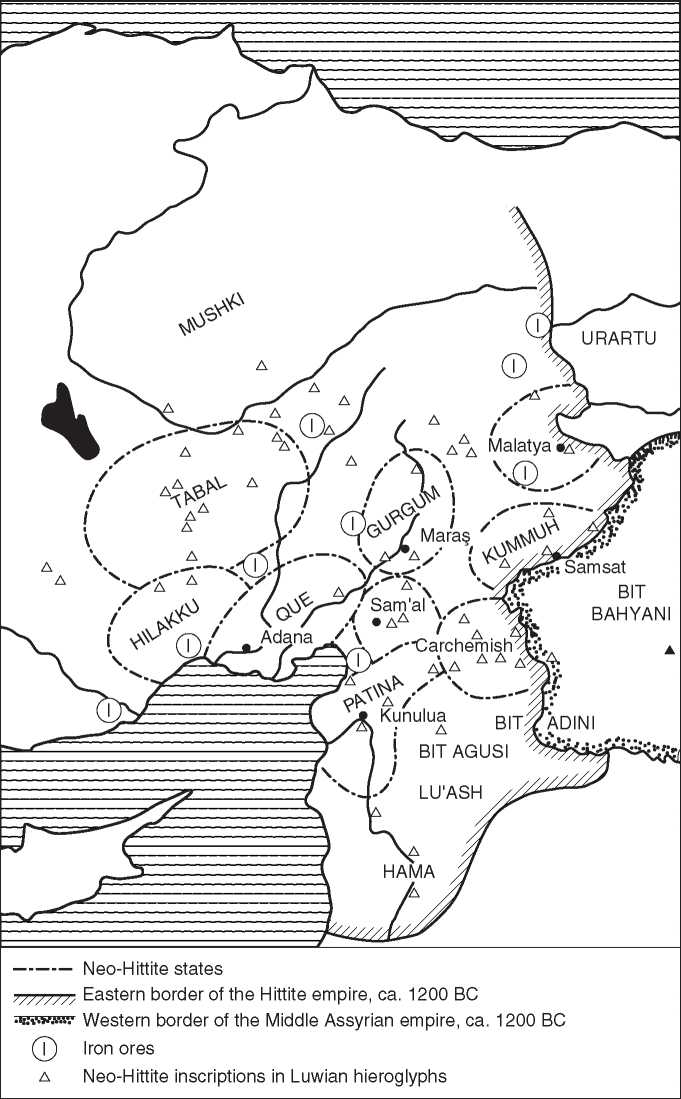Following the collapse of the Hittite empire, the Central Anatolian plateau saw the arrival of new peoples (the Phrygians), which settled alongside the local population. Meanwhile, the political organisation and culture of the area was reduced to the village level. However, the area was beginning to acquire the innovative forms of social organisation and ethnic and national identity characteristic of the Iron Age. On the contrary, in south-eastern Anatolia, particularly in the regions under the control of Carchemish and Tarhuntassa, the population speaking Hittite (and especially Luwian) managed to resist these changes. It developed into a series of local states centred on a city, but including a large territory in the foothills (Figure 26.1).
The most visible sign of continuity with the imperial Hittite phase is the survival of the so-called ‘Luwian hieroglyphs’, which the new states inherited from the Hittite empire. This writing system was already in use in the fifteenth century bc (in the Hittite Middle Kingdom and in Kizzuwatna), and then between the fourteenth and thirteenth centuries bc, particularly on inscriptions left on the seals of kings and functionaries (thus relatively small in size). Towards the end of the empire, Luwian hieroglyphs began to be used on rock monumental inscriptions, such as the ‘historical’ inscription of Suppiluliuma II, found in Hattusa (Sudburg), and other inscriptions left in several locations, including Aleppo. With the rise of the Neo-Hittite kingdoms, the monumental use of Luwian hieroglyphs increased, sometimes even in relatively long texts. These were left both inside cities (on the gates of palaces and citadels) and outside of them (on rock monuments, near wells, sanctuaries, and other important locations). The visibility of these extraurban inscriptions made Luwian hieroglyphs known to us (yet still undeciphered) well before cuneiform. They therefore made Neo-Hittite monuments famous before the archaeological rediscovery of the Hittite empire. This led to the development of more or less interesting interpretations, such as the one identifying the authors of these inscriptions as the Amazons. The travellers of the eighteenth and nineteenth centuries (ad) clearly borrowed this idea from Greek mythology.
As an ideographic system, hieroglyphic writing can be easily adapted to write a variety of languages, for instance Hurrian, used in some personal names of the imperial age. Therefore, while the monuments of the Hittite empire were presumably written in Hittite, the Neo-Hittite inscriptions used a language closely related to Luwian. Even personal names seem more Luwian than Hittite, with the exception of those royal names that were clearly imitating the names of Hittite rulers. This phenomenon can be easily explained. The location of the Neo-Hittite states corresponds to the south-eastern portion of the Hittite empire, where the Luwian element was already prevailing in the second millennium bc. After all, Hittite was only

Figure 26.1 Map of the Neo-Hittite states, ca. 1000—700 bc.
Important because it was the language of the Hittite capital. In reality, even before the destruction of the empire, Hittite language had little impact on the local population.
The general movement to the south-east becomes visible through a comparison between the area occupied by the Hittite empire and the one occupied by the Neo-Hittite states. This shift has led to the assumption that the origins of the Neo-Hittite states was linked to a migration from Anatolia to northern Syria. This movement should have taken place when the empire collapsed, as a reaction to the migration of Phrygians in the central plateau. However, this assumption is not only unfounded, but also unnecessary. The area in which the Neo-Hittite states developed was well within the ancient borders of the Hittite empire. Therefore, the impression of migrations is largely due to the loss of the western and northern territories, and not to a migration of people to the south-east. The Neo-Hittite states bordered to the east with the Euphrates, on the other side of which were the Assyrians. Therefore, the capitals of the Neo-Hittite states overlooking the Euphrates (Carchemish, Kummuh, Melid) were all located along the ‘Hittite’ (that is, western) side of the Euphrates. To the south, the states were barred by the old border between Egypt and Hatti (the southernmost inscriptions are the ones from Hama), and had to move further north due to the movement of Aramean groups.
It is important to make a distinction between the states located to the north or the south of the line formed by the Amanus and the Anti-Taurus. North of this line (Hittite Tarhuntassa) and up to the Halys and salt lakes (beyond which there were the Phrygian territories), a Luwian population had inhabited the region well before the fall of the empire, at a time when the area was part of the Hittite state. South of the Amanus/ Anti-Taurus line (Hittite Carchemish), the majority of the population was Semitic with a Hurrian component. The area used to be divided into autonomous kingdoms dependent on the great king of Hatti. In the course of the fourteenth and thirteenth centuries bc, these kingdoms experienced a certain degree of infiltration of Hittite and Luwian elements. The Hittite dynasties ruling over Aleppo and Carchemish had brought a retinue of functionaries, scribes, soldiers, and merchants. This left a marked Hittite imprint on the palace culture of these two cities. In some areas, from the former kingdom of Mukish (Alalah III) to Emar, their direct dependence on the Hittite viceroys in Carchemish led to a considerable degree of acculturation, attested in the surviving texts and monuments. In the thirteenth century bc, Hittite influence also affected centres such as Ugarit and Amurru, the former through merchants, and the latter through the royal family.
This ‘Hittitisation’ was in a way relatively superficial or, better, only affected the elite. This is because it mainly influenced the palace courts and their administrative and celebrative expressions. The rest of the population remained largely unaffected. Nonetheless, this process was enough to provide the necessary premises for the development of Neo-Hittite culture in centres such as Carchemish and Patina, where it even affected their official expressions. Moreover, the process had a secondary and less obvious impact on centres such as Hama or Bit Adini. In Carchemish, where the cultural and political continuity from the thirteenth century bc to the Neo-Hittite period is evident, the Hittite element pervades its remains. On the contrary, in newer centres, such as Sam’al, the Hittite element was complementary to the predominant Aramean element. This caused a difficult coexistence between official Hittite manifestations and the more widespread Aramean culture.
Despite individual differences, in northern Syria, the Neo-Hittite element mainly affected those areas that had been under direct control of Carchemish in the thirteenth century bc: Carchemish itself, the area ofMuk-ish (which had now become Patina), and partly that of Aleppo. Further south, in the ex-kingdoms of Ugarit, Amurru, Nuhashe, and Qadesh, the rise of the Arameans was facilitated by the common Semitic background they shared with the local population. On the contrary, in the Upper Euphrates, the Taurus, Cilicia, and Cappadocia, the fall of the unifying authority of the Hittite empire had provided autonomy to areas formerly lacking independence. Overall, the collapse of the Hittite empire strengthened both old (Carchemish) and new autonomous states. It is interesting to note that from the collapse to the conquest of the Neo-Hittite states, the Assyrians continued to define the territory west of the Euphrates as Hatti. Carchemish in particular was defined as the ‘great Hatti’. Therefore, despite the fact that each Hittite kingdom was autonomous, the prominence of Carchemish remained, being rooted in the important role the city had in the Hittite empire.




 World History
World History









